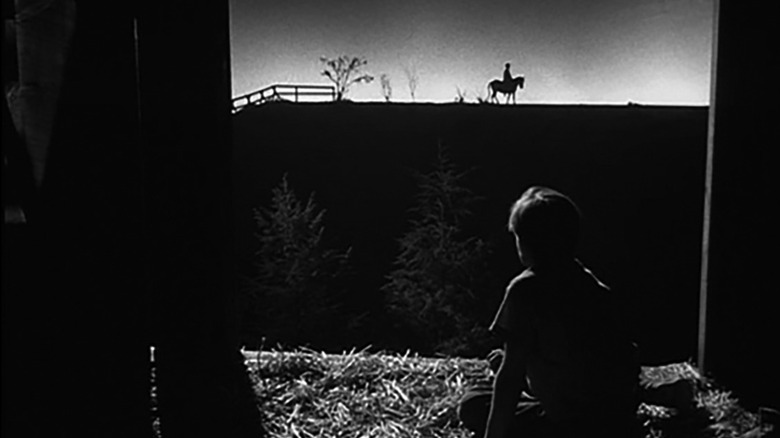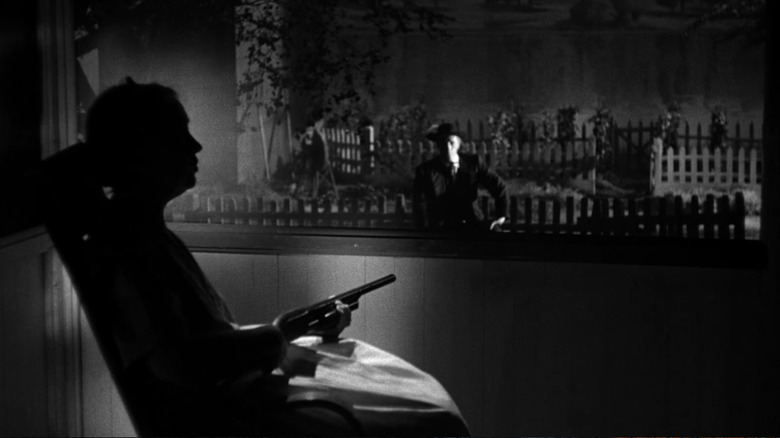How The Night Of The Hunter Used Forced Perspective To Its Advantage
There are fewer joys in filmmaking than successfully pulling off an ambitious movie trick. For example, in his sci-fi classic "The Thing," director John Carpenter hired a double-amputee actor to stand in during the famous defibrillation scene, convincing viewers that Richard Dysart's character had his arms bitten off. The CGI-averse Christopher Nolan similarly orchestrated the zero-gravity hallway fight in "Inception" via massive centrifuge-style rotating sets, earning the film a Best Visual Effects Oscar. But some of the most marvelous movie illusions didn't require elaborate constructions. In fact, one of the most exemplary images of classic cinema was nothing more than a trick of the eye.
Shamefully, "The Night of the Hunter" is Charles Laughton's only feature film as director due to its poor reception at the time. A noir thriller based on the novel of the same name by Davis Grubb, the 1955 movie is now widely considered a true classic. It concerns one Harry Powell (Robert Mitchum), a misogynist preacher and serial killer in pursuit of his executed cellmate's hidden cash stash. The cellmate's children know where the loot is, and once Powell knows that they know, John and Pearl Harper (Billy Chapin and Sally Jane Bruce) must flee for their lives. The children cross a river by boat and sleep in a barn, but Powell is never far behind. John awakens in the barn and glimpses Powell's silhouette on horseback in the distance. "Don't he never sleep?" the boy asks.
It's both a beautiful depiction of looming danger and, coupled with Mitchum's hymnal crooning, is one of the scariest moments of the entire movie. Watch the scene in its full glory here:
One might think that the silhouette image is a fancy-pants sfx shot of Mitchum, but it was actually achieved with the time-honored technique of forced perspective.
Leaning on the everlasting arms of optical illusions
First, a primer: forced perspective is manipulation. Knowing how the human eye perceives objects, a clever storyteller can fiddle with scale, light, and distance to make things appear to have a certain size or proximity in relation to the spectator –- or in terms of filmmaking, the camera. It can be seen in amateur photos of tourists "holding up" the Leaning Tower of Pisa, and writ large it can be seen any time a Hobbit shares the frame with any non-Hobbit throughout Peter Jackson's "Lord of the Rings" movies.
According to the AFI catalog, Powell's silhouette was created on a sound stage where the barn's hayloft was constructed. With the children in the foreground, cinematographer Stanley Cortez had the camera set up behind young actor Billy Chapin, with its lens toward the soundstage depicting the partially-fenced far reaches of farmland. What is assumed to be the preacher on horseback is actually Billy Chapin's stunt double on a pony. From the camera's vantage point, Billy is watching a much-taller man advancing across the distance.
Cortez explained (via American Cinematographer Magazine):
"We built the hayloft almost to the top of the stage and had a half-moon doubled in. The stage was very small, and our idea was to give it some depth. That was a [little person] on a pony riding along, not Mitchum on a plow horse. It was shot from the top of the stage looking down. The impression was gotten over dramatically, a dramatic concept to communicate to the audience — sort of being colorful in black-and-white."
Despite being a 1955 movie set during the Great Depression, "The Night of the Hunter" has a timeless fairytale quality thanks to its movie magic techniques and its evergreen story of good versus evil.

